-
Posts
4,346 -
Joined
-
Last visited
Content Type
Profiles
Forums
Events
Store
Posts posted by Chris Davidson
-
-
The station# overlap (3+29.2) of both CE884's at z161 + z168 can be sorted out this way:
(14.94mph) 21.96ft per sec - 19.76ft per sec (http://educationforum.ipbhost.com/index.php?/topic/22692-swan-song-math-rules/&do=findComment&comment=328146) = 2.2ft per sec =1.5 mph
If you do the math for the initial two entries of both CE884's (z161-z166) and (z168-z171) you'll find the speeds are 2.24 and 3.74. Difference = 1.5mph
-
The previous post is ultimately showing the difference between a starting speed and ending speed converted via 48fps, which includes the 18.3/18fps conversion, ending with the magical 3.74mph difference (14.94-11.2) = 5.49ft per second.
Or, what happens when you have the limo traveling 3 frames (z168-z171 WC CE884 final plat) for a total of .9ft = 3.74 mph = 5.49ft per sec
btw, something that needs to be remembered: the whole frame conversion from 18.3 to 18 for that 5.49ft per sec total = 5.49ft per sec / 1.016666 = 5.4ft per sec.
-
36 minutes ago, Chris Davidson said:
Answer =1.01666666667 not 1.106666667. The needed adjustment to make 18fps into 18.3 fps
The above ratio should help you understand in terms of limo speed conversions too.
Example: CE884 WC final plat: 14.94mph (z168-z186 = 21.6ft @18fps) x .7625 = 1 / (48/18.3) / 2) = 11.39mph / 1.016666667 = 11.2mph = Shaneyfelt testimony = average limo speed z161- z313.
-
No.
In the end, the ratio's would work out.
-
4 hours ago, David Josephs said:
1 / by previous result = 1.106666667 = the needed adjustment to make 18fps into 18.3 fps = Elm incline = 1 vertical foot per second of film after POS A
Answer =1.01666666667 not 1.106666667. The needed adjustment to make 18fps into 18.3 fps
-
On 6/16/2017 at 5:29 PM, Chris Davidson said:
Bottom line - we both know that those 6 seconds were not what originally came out of that camera, that day, as a result of Zapruder filming.
Did you mean 26.5479 seconds?
You've got it.
The difference.
Simplified: (18.3/48)= .38125 -.375 = .00625 x 1274.3 = 7.96
-
David,
Anyhow, I don't want to get into the sideshow that is Position A right now.
You asked me earlier how they arrived at 18.3fps as their final frame rate.
Besides the 1 to18.3 ratio of ElmSt vertical to horizontal,
Part of that determination was dealing with whole frames in their calculations. If you run this entire equation on a calculator:
48/18.3 =
That result x .375 =
1 / by previous result =
That result x 18 (whole frames) = 18.3fps
You know what the importance of .375 equates to in terms of frame removal.
-
Ridiculous lead height 6.7 inches for a car traveling approx 11.2 mph at extant z207
That must have been an awfully slow traveling bullet that hit 10.2ft farther down the road.
Instead of converting the .56ft to 6.7 inches purely vertical, just convert it using the Elm St vertical:
.56 x 18.3 = 10.248ft
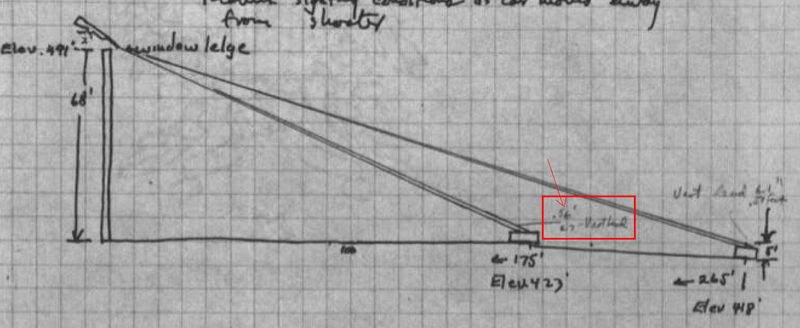
-
9 hours ago, David Josephs said:
Ok, let's forget NPIC for now.
Should be obvious since z312 as the last shot was immediately contradicted by the surveys.
The Nov 26 Time/Life survey has shot one 163' from the TSBD corner... except the surveys put it at 423.07 which is 172 feet from the same spot.
Not from the TSBD corner, but directly below the 6th floor window forming the base of the triangle.
In essence, that 163ft + distance represented what was extant z207 = Station# 3+71.1
Elev. 423.07 represents Station 3+81.3, a difference of 10.2ft between them.
WCD298 from Dec's survey data squarely puts a shot within 4 feet of 5+00 as does the Feb FBI survey as does CE875 - as we both know.
The real question is whether this 3rd shot was CREATED and REMOVED, or ACTUAL and REMOVED and can that be proven.
Well put.
Proven? Maybe by a preponderance of the data. Let's wait and see.
With the need for a third shot and have 2 shots defined with z312 the 2nd shot, they needed a place for a third shot which would not interfere, with what Shaneyfelt did not the path of the limo and shot locations.
Shaneyfelt melding shots.
Couldn't be before 207 with the tree and Position A as rationale.
COULD be between 207 and 312 since it was 42 frames for a reload and 207 + 42 = 249 + 42 = 291... Which is why NPIC has 242 and 256 as frames with potential shots
COULD be after 312 since the FBI's position was 3 shots = 3 hits with the last hit being the head shot... 40 feet further down Elm.As usual the exhibits negate the narrative.
When you extract the WC measurements given for StationC, PositionA and z161 starting with CE886.
It works out like this:
z161 = Station # 3+29.2
Distance from z161 to Station C = 94.7ft which means StationC = Station# 2+34.5
Distance from Position A to Station C = 44ft
Position A = 2+34.5 + 44ft = Station# 2+78.5
Position A = Elev 431.97 - 3.27ft = 428.7 CE884 entry
TSBD snipers nest base = Station# 2+50 = elev 429.7
Difference in elev between TSBD snipers nest base and Position A = 429.7 - 428.7 = 1ft vertical
Position A 2+78.5 - TSBD 2+50 = 28.5ft
28.5ft -18.3ft = 10.2ft
28.5ft/18.3ft = 1.557... elev change
Difference between 1.557... and 1ft vertical = .557... x 18.3 horizontal conversion = 10.2ft
Distance difference between Time/Life survey and SS/FBI plat shot #1 = 10.2ft
-
This is why I suggested setting it aside for now.
Both notes start with z188.
One uses 16fps the other 18fps.
In your previous post one example provided: PANEL 4.... 8 second mark at the start of z331
z331-z188 = 143 frames /18fps = 7.94 seconds
That just reconfirms the notion of an altered film. "I guess I just yet see it that way."
Was "just" supposed to be the word "don't"?
"I also believe that by the time these boards were made the film had been completely altered down to those 486 frames."
Agreed. As the boards match the extant zfilm.
Moving forward, I think you'll realize why I choose not to delve into this too deeply, right now.

-
17 hours ago, David Josephs said:
17 hours ago, David Josephs said:Let's stay with 1 second of time = 18-19 frames = 18.3fps = z188 thru z206 on PANEL 1
16 total frames "missing" ; 3 total frames shown ; 1 second occurs .3 of the way into frame 206.
When we make the assumption that those 18 frames come from 48 we automatically make the math work,
The camera has the capability to shoot at 48fps slow-motion.
Let's say those 18-19 frames were actually filmed at 1000fps ... as long as the boards are labeled as they are, how would we know the filmed frame rate?
We wouldn't.
So isn't it pure mathematical coincidence that 48 x 1/2 x 1/4 = 18 due to 18 and 48 being divisible by 6 and 3, magical math numbers.
Could be. But then again, since I've gone through and recreated a film using 48fps as the real rate, which matches the extant zfilm, I tend to believe a sequential removal of 1/2 then (1/4 of 1/2), is likely to appear in other areas.
There is no way to know if 981 frames were removed from a 1000fps film so we're back to the B&H settings... 16 and 48fps
Unless this camera possessed the newer changeover fps rate of 18.
It would require the creation/addition of frames if the film was taken at 16fps or a completely different frame numbering system
Agreed. Do you know of a method available for creating new from existing frames back then?
So we are GIVEN the 48fps as the only possibility above 18.3fps for that film to originally be shot. Filming the recreation at 24fps indeed is a strong indication that the first pass removal of frames would be 50% of the frames. Now comes the part whether there was another 1/2 of the 50% = 6 frames, or 1/3 of the 50% = 8 frames.
1/2 + (1/3 x 1/2) = 4/6= 2/3
The limo speed differences indicate a removal of quarters not thirds nor sixth's.
To get to the 16fps they would have removed 1/3 of the and would have matched the actual available camera speeds... but they did not take this easy route, the 2nd 1/2 removal from 50% of the remaining frames plus/minus a few frames gets them to their 18.3 (to match Elm's incline and make the remaining calcs easier)
Same answer as previous.
486 frames net divided by 75% = 648 frames before removing 25% and then double it for the first 50% = 1296 total starting frames / 48fps = 27 seconds = 486 / 18.
At 18.3fps the run time is 26.56 seconds. That is .44 seconds faster which equates to 21-22 frames at 48fps or 8 frames at 18.3fpsThat's along the right line of thinking. Use their numbers for more accuracy.Added on edit: Nicely done David. 486/1296 = .375kept .625removed
For example: 48/18.3 = 2.622 x 486 = 1274.3 / 48 = 26.54775 sec.
Again, more than likely 48fps was double stepped down to 18.3 by taking 50% of the frames away then 50% OF THE TOTAL again from the 48fps original.Exactly what I've shown with the previously provided film.Added on edit: Not Exactly. 1/2 step-down, they then figured out the limo starting frame # on film (cut the appropriate amount of frames out) , from there, they removed 1/8 of the remaining frames = 1/4 of the remaining 1/2 frames from the original step-down.
If there were frames between 132 and 133 they were completely removed and have no bearing on the 486 extant frames.
Exactly. Even though you can figure out how many frames they did excise from the beginning of the film through what they have labeled as z133.
At .149" from frame start to frame start, 486 frames = 72.414" = 6.03' of film yet there is 6' 3" of film at the archive.
2.97" of film = 20 frames or about 1 second
One meter = 3.28084' = 264 frames = 39.37" = .149" per frame including the space between frames (according to Wiki)
75"/39.37" is the ratio of total length to a known quantity = 1.905 x 264 frames = 504 total frames - 486 = 18 frames or about one secondOne foot of 8mm film = 80 frames. This might be an easier conversion when dealing with the Horne archive measurements.
Horne excerpt: "the extant film (that is, the assassination movie, not the Zapruder family scenes present on the two Secret Service copies) in the National Archives (not counting leader) consists of a strip of film 8 feet, 10 inches long" and 2 feet, 7 inches is black, unexposed film with no image showing);
8.83 x 80 = 706.4frames / 2 = 353 frames. Does this tell us at some point that they had 2 versions of 353 frames they were working with since we don't know what was on the 2.58ft= (206.4frames) strip that was unexposed.
Chris - I seem to have got lost in the math... trying to do too many things at once. Am I making sense with the 18 to 18.3 fps comparison? Does the length of the film and # of frames resulting in an extra 18-20 frames add up to you? 75" of film equates to too many frames...
Did Horne include the partial footage of the Hesters at the beginning of the zfilm in his measurements?
what can be derived from this? your help as always is greatly appreciated
The differences are the most important part of the math solution.
Sorry about some of the extraneous gestures I throw in, I'll try and keep that streamlined in the future.
Lets not get hung up on the NPIC quagmire for now. I think the most important part of that scenario is the labeling of missing frames by someone.
That just reconfirms the notion of an altered film.
DJ
-
1 hour ago, David Josephs said:
Yet we are removing just short of 2/3 of the frames, not 1/3. ??
Yes. .625 is just short of .667
And your math is simply stating the same thing in different ways.
In differences I hope.
There are 3 frames shown on the board for 188-206 and 16 missing frames with 1 second coming at 18.3 frames or the middle of 206. Multiplying both sides of the equation by 3 to get to 48fps resulting in the 5/8ths and 3/8ths %'s.
Showing how a 2 pass operation could work in 1 second of time. Just like the difference of 3.74mph in 1 second of time CE884 (final plat) z168-z186.
And why do you keep using 1/3?
Would it be easier to add or subtract frames using an optical printer?
1/3 + 1/3 = 2/3 x 486 = 324
Finally, these frames are simply not shown... whether there are 48 frames to a second or not, the board show 18.3 fframes for each second...
Actually, in whole frames, the board shows 18/48 = .375
the rest of the boards have missing frames as well...
Yes, I'm aware of this.
??
-
On 6/18/2017 at 1:29 AM, Chris Davidson said:
Extant z188-z222 = 34 frames
NPIC labeling of missing frames for this same span = 29 total frames
188-198 = 9 missing frames
198-206 = 7 missing frames
206-213 = 6 missing frames
213-216 = 3 missing frames
216-222 = 4 missing frames
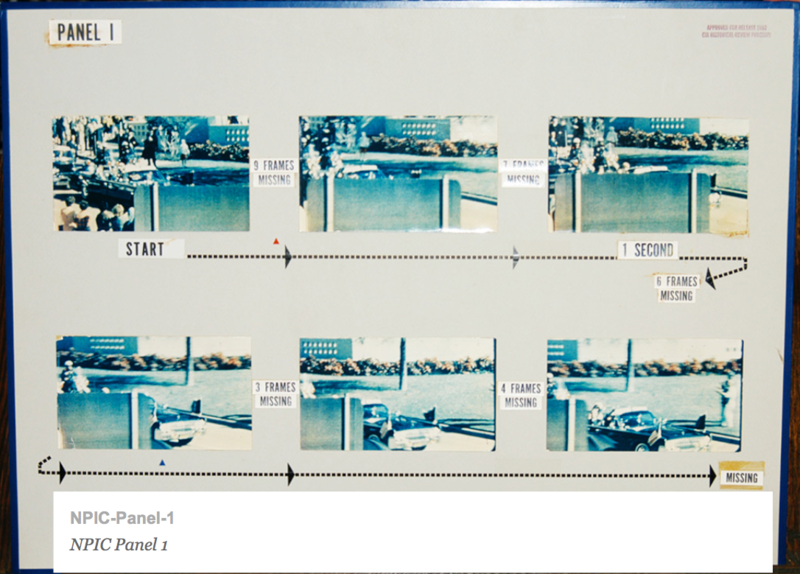
Think of the 29 missing frames as the shortcoming of a film that would initially have 1/3 of the frames removed.
It goes like this:
1/3 x 486 = 162
486 - 162 = 324
324 + (29 shortcoming frames) = 353 frames = z133-z486
(3/8).375 - (1/3) .333... = .041666... x 48 = 2.000... frames = difference between frames kept 18 (z188-z206) and frames removed 16 (9+7) within the same 48 frame (1 second) span.
-
On 6/18/2017 at 1:29 AM, Chris Davidson said:
Extant z188-z222 = 34 frames
NPIC labeling of missing frames for this same span = 29 total frames
188-198 = 9 missing frames
198-206 = 7 missing frames
206-213 = 6 missing frames
213-216 = 3 missing frames
216-222 = 4 missing frames

David,
The briefing board confirms the 1/2 then 1/4 step-down.
They provided us a huge clue when they listed the 1 second increment.
Converting that 1 second increment to 48fps is the key:
48/2 = 24 frames
24 x .25 (1/4) = 6 frames
24frames -6 frames = 18 frames between the span.
18 frames is the span that is shown on the briefing board which matches the extant film.
18/48 = .375 = what's left when removing .625= 1/2 + 1/8(1/2 x 1/4)
-
On 6/16/2017 at 2:06 PM, Chris Davidson said:
Keep thinking in terms of ratios.
1/2 = .5
1/2 x 1/4 = 1/8 = .125
.5 + .125 = .625
Closest ratio to 1 / (48/18.3) = .38138 is: .375 + .625 = 1 whole frame
You can apply the frame removal ratio to the existing framework.
.375 x 353frames(z133-z486) = 132.375 frames
353 + 132.375 = 485.375 = 486 whole frames
Using the ratio dictates the starting and ending points for the extant zfilm.
-
Extant z188-z222 = 34 frames
NPIC labeling of missing frames for this same span = 29 total frames
188-198 = 9 missing frames
198-206 = 7 missing frames
206-213 = 6 missing frames
213-216 = 3 missing frames
216-222 = 4 missing frames

-
NPIC indication of the initial 1/2 step-down?
Added on edit: Since there was no frame numbering system via NPIC during this time period, that I know of, the labeling of missing frames just further cements the conclusion that some type of step-down process was in action.
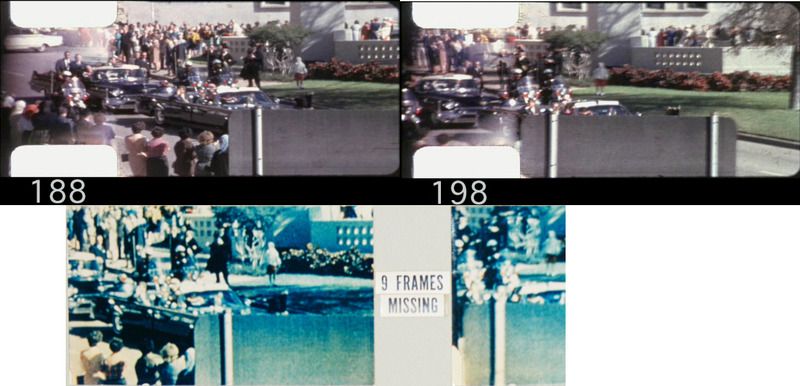
-
3 hours ago, David Josephs said:

It would have to be...
Some of the difficulties encountered were figuring out the shorter spans first and then connecting it to the overall.
makes more sense that it was all filmed at that speed..
If I wasn't clear, I do believe the entire sequence was shot at 48fps.
That would be from z1-z486. And this z1 would not be what we see from the extant film, obviously.
The other equations I've created (not introduced yet) are from the entire sequence, not specific spans such as 171-334, those smaller spans just legitimize the overall. Especially, when using both CE884's and Myers work.
I know you prefer to stay away from what the math suggests... the "how"... yet if it was done this way, there is a "how",
whether we can conceive of it is another question entirely.If what was done what way?
-
31 minutes ago, David Josephs said:
I'm agreeing with you wholeheartedly about the initial 24fps cut down for any running film taken at 48fps.
Thanks. I know you were.
And by obvious observation all frames = those removed plus those that remained
I'm not as inclined to accept that they simply did that again due to the choppiness even when seen stabilized.
Yet, the intervals work, and most importantly, the Kodak film edge markings remain correctly spaced.
Removing 2/3 at a time does not work.
What I am leaning toward is the relationship between the slope and the camera speed. By syncing them as they did, 1 second of film equated to 1 foot of vertical height, and how important the various changes in measurements were based on the correct heights involved.
You are wise to keep this in mind. They had to tie-in multiple shots to one snipers nest location.
More on that later.
Cutting it all the way down to 16fps would not have been that much more difficult and would have matched with the specs of the camera... so why 18.3?
It served their needs.Agreed, but 16fps did not allow for enough frames for ultimate syncing.
I don't think we need to be 100% in agreement on the process despite how much easier a 24fps 1st pass would be.
A half and a quarter will get you the extant film. The math works with it, which is the most important part.
How in-depth in terms of an optical printer is up for discussion.
Bottom line - we both know that those 6 seconds were not what originally came out of that camera, that day, as a result of Zapruder filming.
Did you mean 26.5479 seconds?
-
1 hour ago, David Josephs said:
334 - 171 = 163 frames @ 18.3fps = 8.9 seconds of film x 48fps = 427 frames @ 48fps between z171 & z334
427 / 2 = 213.6 @ 24fps (1st pass = 213.4 frames removed) - 50.6 frames (just under 25% of the 213.6 @ 24fps) = 163 frames @ 18.3fps
David,
Putting the above frame reduction into a speed difference:
From this previous post: http://educationforum.ipbhost.com/index.php?/topic/9975-splice-in-tina-towner-film/&do=findComment&comment=354510
3.734mph/14.94mph = 1/4.
Myers difference confirms it and so does CE884 (final plat version) entries for z168-z186.
Keep thinking in terms of ratios.
1/2 = .5
1/2 x 1/4 = 1/8 = .125
.5 + .125 = .625
Closest ratio to 1 / (48/18.3) = .38138 is: .375 + .625 = 1 whole frame
-
48fps stepped down to 18.3:
Starting at Z133 through the end, the percentage missing is approx 61.87 %
A sample of this 61.87% overall frame removal process below:

If you want to include the frames missing from Z1 - Z133 also, the percentage of total frames missing would be approx 72.3%.
-
The WC being the smart entity that they were and in keeping with the correct ratios, quite properly assigned 25 frames (officially published CE884) to the same distance traveled for 18 frames - z168-186.
Since 1 second of time equaled 18.3fps not 18fps, and part of the 48 to 18.3fps conversion included an approx 24fps step down, then the equivalent would have been the next whole frame or 25 frames.
This might be the easiest way to recognize what conversions were occurring if you are not interested in the math equations.
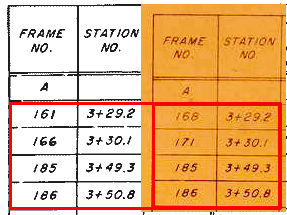
-
And, according to CE884 entered on the final WC plat of May1964, you can find these common speeds in the first entries provided (z168-z186)
Overall entry of 21.6ft traveled in 18 frames = 21.96ft traveled in 18.3 frames = 1 second = 14.94mph
And, the first entries from z168-z171:
3 frames = .9ft traveled = 18.3frames (1 sec) / 3 frames = 6.1 x .9ft = 5.49ft per sec = 3.734mph
Now, to arrive at Shaneyfelt’s magic 11.2 mph , just take 14.94mph - 3.74 mph =11.2mph.
In frame removal format, 3.734/14.94 = 1/4. Or, just apply it to the previous gif provided.

-
Once you realize that part of the reduction from 48-18.3 included reducing the frame count via one pass = close equivalent to 24 fps, you can then put the SS recreation in its proper context. Yes, the recreation was shot at 24fps for this specific reason.
Or, a car traveling at 14.94 mph / (24/18.3fps) / (18.3/18 whole frames) = 11.2mph = Shaneyfelt slip-up BS.
Equals the importance of a 3.74mph difference: http://educationforum.ipbhost.com/index.php?/topic/9975-splice-in-tina-towner-film/&do=findComment&comment=354306
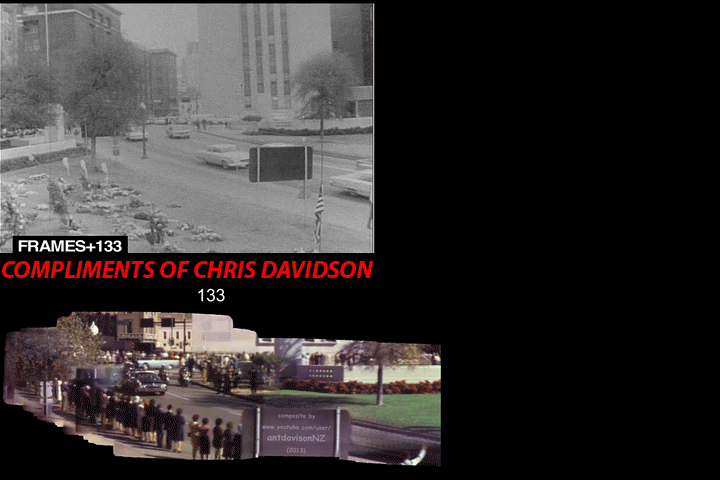


Splice in Tina Towner Film
in JFK Assassination Debate
Posted · Edited by Chris Davidson
Need to re-phrase what was here previously.
Added on edit:
CE884 WC final plat: 14.94mph (z168-z186) 21.96ft per sec / 48 frames = .4575ft per frame
12frames x .4575 = 5.49ft
21.96ft - 5.49ft = 16.47ft per sec = 11.2. mph
Quite simply: 13.44mph (19.76ft per sec) /14.94mph (21.96ft per sec) = .8995... x 18.3fps = 16.462..ft per sec = 11.2mph= Shaneyfelt testimony
The match being: .7625 = (1/1.3114)= (48/18.3) / 2) x 14.94 = 11.39mph / 1.01666667 = 11.2 mph